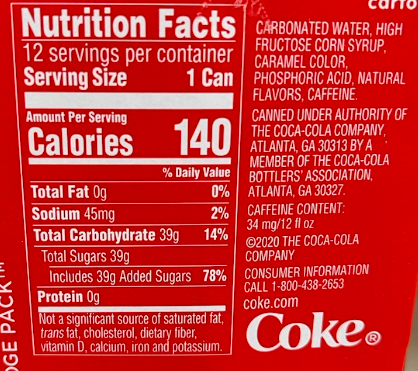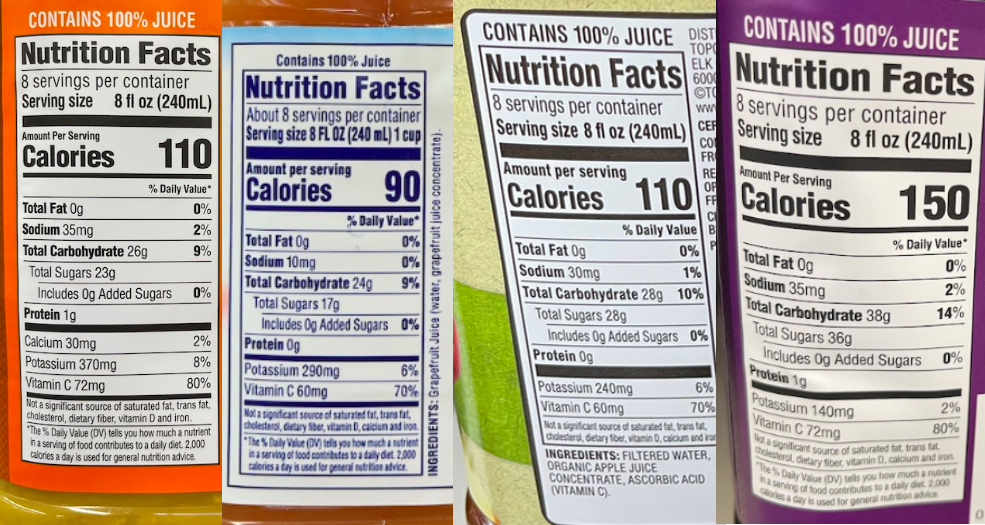While much of what the U.S. government has done relating to food and nutrition has been counterproductive at best (such as the food guide pyramid), its incorporation of ingredient and macronutrient information in food labels is mostly helpful when read with discernment.
One thing you’ll find is that sugar is everywhere.
When you read a food label, if you see SUGAR, BROWN SUGAR, HONEY, HIGH FRUCTOSE CORN SYRUP, SUCROSE, DEXTROSE, LACTOSE or any other -OSE – especially among the first few ingredients – stay away!
Juice is a special case, though. When you review an ingredient label for 100% fruit juice, you might see lists like:
- INGREDIENTS: FILTERED WATER, ORGANIC APPLE JUICE CONCENTRATE, ASCORBIC ACID (VITAMIN C)
- INGREDIENTS: Grapefruit Juice (water, grapefruit juice concentrate)
What could be wrong with those? They’re “all natural” or maybe even “ORGANIC”!
It doesn’t even list sugar as an ingredient.
Well, let’s do a comparison.
Few would consider Coca-Cola (or any other sugar-sweetened carbonated beverage, for that matter) a healthy drink. (I’m not picking on Coke, here; it’s actually the soda, or “pop” depending on your region, that I have most enjoyed over the years.)
Look at its Nutrition Facts label, you’ll see plenty of warning signs:

Obviously with High Fructose Corn Syrup behind only water among its ingredients, you’ll expect this to be high in sugar. And sure enough, each 12-ounce can has 39g of Total Sugars (all of them Added Sugars.)
That’s bad, right?
Well, let’s compare with several 100% fruit juices:

Each these lists “0g Added Sugars” as if that’s something of which the bottlers should be proud. I realize that’s an item the government requires them to note, but it detracts from the real news, which is that for an 8-ounce serving, total sugars for these juices are:
- Grapefruit – 17g
- Orange – 23g
- Apple – 28g
- Grape – 36 g
When adjusted to the same serving size as a can of Coke (and rounding down to be generous), those range from 26g to 54g for 12 ounces.
Apple juice and grape juice actually have more sugar per ounce than Coke!
Here’s my confession: in the last half of the 1990s, I would regularly stop at the convenience story on my morning commute and buy a quart of orange juice to drink on the way to work!
I actually thought that was a healthy choice! I mean, it had Vitamin C, right?
Based on the figures above, I was getting 92g of sugar before 8 a.m. almost every workday. And that was after I had eaten a bowl of cereal that typically included 16g of sugars and 41g of total carbohydrates.
I might as well have had a 48-ounce Coke for breakfast!
Fruit in reasonable quantities is good because it carries fiber with it, which fills you up and also slows the absorption of sugar into the bloodstream.
But my Nordic ancestors didn’t have fresh fruit year-round, and yet somehow here I am today. Fruit is less necessary than you may think.
So as you’re taking #BodyBabyStep One, quitting fruit juice (and all other sugar-sweetened beverages) is essential.
Don’t do as I did; do as I do now.
I drink coffee black, or with fat-based additives that don’t cause blood sugar spikes and also slow release of caffeine.
More on that next time.
If you think your friends might find this post and this series helpful, I hope you’ll share by email or on your social networks using the buttons below.
You can subscribe by email, and I’ll also post links on Facebook, Twitter and LinkedIn.